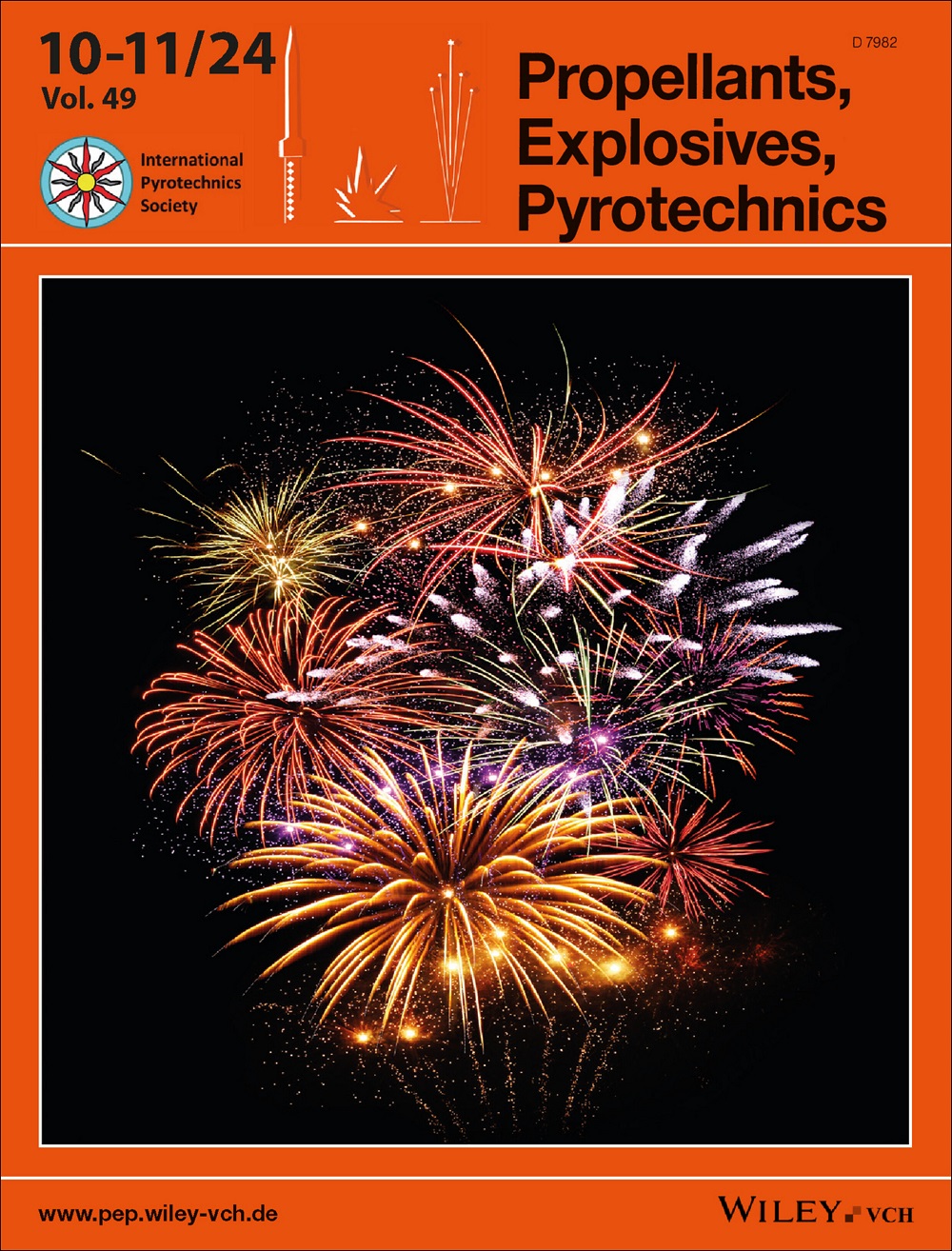Mesoscale formation and energy release characteristics of PTFE/Al reactive jet
IF 2
4区 工程技术
Q3 CHEMISTRY, APPLIED
引用次数: 0
Abstract
In order to investigate the mechanical formation, the mechanical‐thermo coupling mesoscale mechanism and the corresponding energy release characteristics of PTFE/Al composite material reactive jet, a mesoscale discretization model of PTFE/Al reactive liner with a mass ratio of 73.5 %/26.5 % is developed on the basis of the random delivery principle. The mesoscale numerical simulation is used to perform PTFE/Al reactive jet formation, obtaining the relative distribution characteristics of material, pressure, and temperature. The overpressure experiments for the energy release of reactive jets are conducted. The results show that there is an increasing tendency in the amount of Al particles from the jet's tip to its tail due to the velocity variance between PTFE and Al. The high temperature zones are found to be concentrated on the tip and axis of the jet, with particle deformation, collision and friction in the reactive jet accounting for the temperature rise. Moreover, the Al particle size has a significantly influence on the particle distribution and the mechanical‐thermo coupling behavior in the reactive jet, and the decrease of particle size is beneficial to the chemical reaction among the components of the reactive jet. To be more specifically, under the conditions of Al particle size of 400 μm, 600 μm and 800 μm, the overpressure peaks of reactive jet in 13 L chamber are 3.32 MPa, 2.86 MPa and 2.61 MPa, respectively. The variation of the overpressure with Al particle size obtained by experiment is consistent with the analysis of the mechanical‐thermo coupling characteristics of mesoscale numerical simulation.聚四氟乙烯/铝反应射流的中尺度形成和能量释放特性
为了研究聚四氟乙烯/铝复合材料反应射流的力学形成、力学-热力学耦合中尺度机理及相应的能量释放特性,基于随机输送原理,建立了质量比为 73.5 %/26.5 % 的聚四氟乙烯/铝反应衬垫的中尺度离散化模型。中尺度数值模拟用于 PTFE/Al 反应射流的形成,获得材料、压力和温度的相对分布特征。进行了反应射流能量释放的超压实验。结果表明,由于聚四氟乙烯和铝之间的速度差异,铝粒子的数量从射流顶端到尾部有增加的趋势。高温区集中在射流的顶端和轴线上,粒子在反应射流中的变形、碰撞和摩擦导致了温度的升高。此外,铝的粒度对反应射流中的颗粒分布和机械热力学耦合行为有显著影响,粒度的减小有利于反应射流中各组分之间的化学反应。更具体地说,在铝粒径分别为 400 μm、600 μm 和 800 μm 的条件下,13 L 反应射流的过压峰分别为 3.32 MPa、2.86 MPa 和 2.61 MPa。实验得出的过压随 Al 粒径的变化与中尺度数值模拟的力学-热力学耦合特性分析结果一致。
本文章由计算机程序翻译,如有差异,请以英文原文为准。
求助全文
约1分钟内获得全文
求助全文
来源期刊

Propellants, Explosives, Pyrotechnics
工程技术-工程:化工
CiteScore
4.20
自引率
16.70%
发文量
235
审稿时长
2.7 months
期刊介绍:
Propellants, Explosives, Pyrotechnics (PEP) is an international, peer-reviewed journal containing Full Papers, Short Communications, critical Reviews, as well as details of forthcoming meetings and book reviews concerned with the research, development and production in relation to propellants, explosives, and pyrotechnics for all applications. Being the official journal of the International Pyrotechnics Society, PEP is a vital medium and the state-of-the-art forum for the exchange of science and technology in energetic materials. PEP is published 12 times a year.
PEP is devoted to advancing the science, technology and engineering elements in the storage and manipulation of chemical energy, specifically in propellants, explosives and pyrotechnics. Articles should provide scientific context, articulate impact, and be generally applicable to the energetic materials and wider scientific community. PEP is not a defense journal and does not feature the weaponization of materials and related systems or include information that would aid in the development or utilization of improvised explosive systems, e.g., synthesis routes to terrorist explosives.
 求助内容:
求助内容: 应助结果提醒方式:
应助结果提醒方式:


